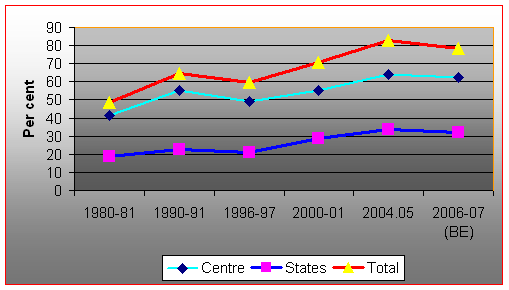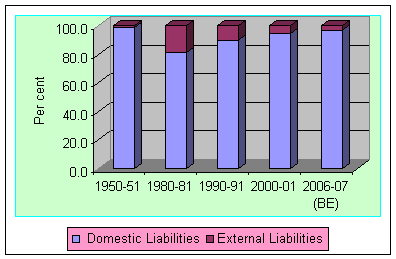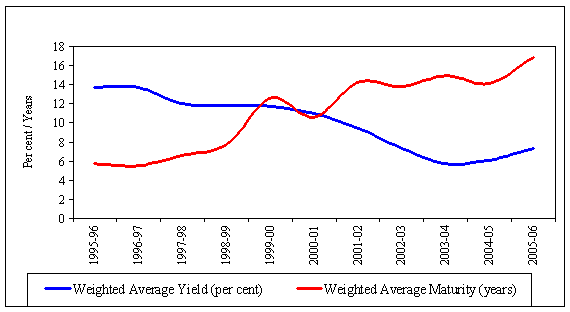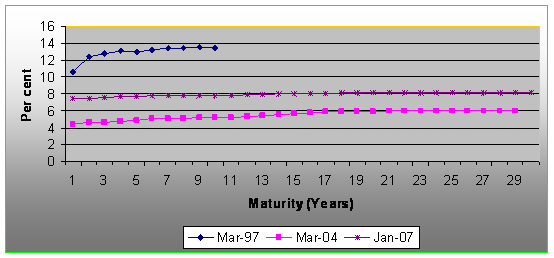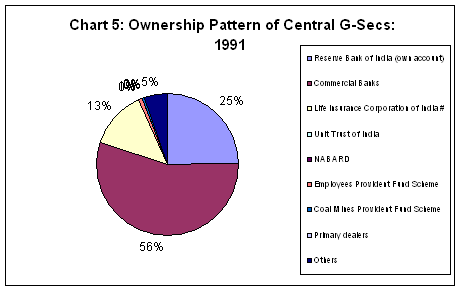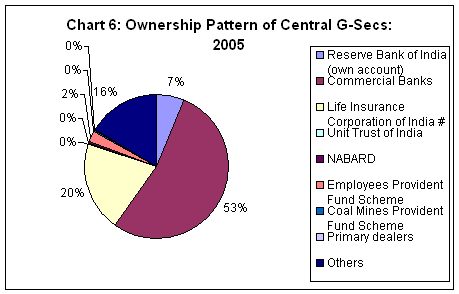Development of Local Currency Bond Markets : The Indian Experience - RBI - Reserve Bank of India


Development of Local Currency Bond Markets : The Indian Experience
Smt. Shyamala Gopinath, Deputy Governor, Reserve Bank of India
Delivered on Mar 06, 2007
Development of Local Currency Bond Markets : It gives me great pleasure to participate in the Workshop on "Debt, Finance and Emerging Issues in Financial Integration", being organized by the Financing for Development Office, United Nations in collaboration with the Commonwealth Business Council and Commonwealth Secretariat. In my presentation, I would like to highlight the Indian experience with regard to the development of debt markets. As you are all aware, the imperative of developing domestic debt markets has been reinforced by the lessons of the financial crises that affected a large number of countries in East Asia and elsewhere in the late 1990s. Indeed, the significance of a well-persified financial system, including a deep and liquid bond market, that obviates excessive dependence on the banking system, and helps avoiding the double mismatches of currency and maturity, was quite tellingly felt in the context of the crisis. In India, the development of government bond market has been taken up as part of the structural reforms process initiated in 1991-92 in the aftermath of the external payments crisis in the previous year. The external payments crisis was largely engendered by the deteriorating fiscal situation during the previous decade which was marked by high and persistent fiscal and revenue deficits, substantial debt-servicing burden, captive use of bank resources at sub-market clearing rates and increasing recourse to monetary financing of the budget deficit with its attendant inflationary consequences. The structural reform process that was initiated as a response to the crisis included apart from fiscal reforms, industrial deregulation, liberalization of foreign direct investment, trade liberalization and financial sector reforms. The objective of these wide-ranging reforms was to place the economy on a higher growth trajectory by inducing greater efficiency and competitiveness in all spheres of activity. Within this overall context, reforms in the Government securities market were undertaken essentially to finance the budgetary requirements of the government in a non-inflationary and more ‘efficient’ manner; develop a benchmark for the pricing and valuation of other securities; and facilitate monetary policy operations through indirect instruments in the context of a liberalised financial environment. Borrowing by the State Governments is subordinated to prior approval by the Central Government. This is embodied in Article 293 of the Indian Constitution, under which, any State Government that is indebted to the Central Government, requires prior approval before borrowing from financial markets. Furthermore, State Governments are not permitted to borrow externally, unlike the Centre. The local debt market comprises the Government securities market (of both the Central Government and the 28 State Governments) and the corporate bond market. The Reserve Bank of India (RBI) is the banker to and manager of marketable internal debt of the Central Government by statute. Internal marketable debt, at present, accounts for around 40 per cent of the total outstanding debt of the Central Government, whereas net market borrowings account for around 77 per cent of the Gross Fiscal Deficit (GFD). The RBI is a banker to and manager of the marketable debt of the State Governments under voluntary agreements. Internal marketable debt, at present, accounts for around 20 per cent of the total outstanding liabilities of the State Governments whereas net market borrowings account for around 20 per cent of their GFD. Against this backdrop, the structure of my presentation is as follows. In Section, I shall briefly trace the evolution of deficits and debt of the Central Government over the period of reforms. In Section II, I shall discuss the various initiatives for the development of the Central Government debt market. Section III would highlight the impact of the reforms on various parameters of the Central Government debt market. The next two Sections would be devoted to the trends in the deficits and debt of the State Governments and issues relating to their market borrowings, respectively. Issues relating to the development of the corporate bond market would be covered in Section VI. The Concluding Section would highlight a few issues in the way ahead. I. Trends in Budget Deficits and Debt of the Central Government Three distinct phases in fiscal performance of the Central Government are evident since the initiation of reforms in 1991-92. In the first phase, which lasted upto the mid-1990s, there was a significant reduction in fiscal deficit from around 8 per cent to 5 per cent of GDP and in the public debt from 55 per cent to 51 per cent of GDP. During this period, fiscal correction primarily reflected curtailment of investment expenditure, even while major tax reforms were initiated via reduction/rationalization of rates and widening of the tax base. Table 1: Trends in Centre’s Budget Deficits (as per cent of GDP)
Table 2: Financing Pattern of the Centre’s Gross Fiscal Deficit (in per cent)
Note: The balance amount represents draw down of cash balances Chart 1: Trends in the Debt of the Central and State Governments (as a ratio to GDP)
In the second phase, which covered the next five to six years, there was, however, a significant reversal of trend with the fiscal deficit and public debt increasing, as a ratio to GDP, to around 6 per cent and 64 per cent, respectively. The revenue deficit increased to over 4 per cent of GDP during this period, which was even higher than the level prevailing on the eve of the crisis. Deterioration in the fiscal situation during the second phase even while reform efforts continued, was related, inter-alia, to (a) the slowdown in the growth rate of the economy which adversely impacted on tax revenues; (b) upsurge in expenditures on wages and salaries of the government sector consequent to the Fifth Pay Commission award; and (c) the increase in interest payments following the sharp rise in yields on Government securities in the first phase following the introduction of auctions. In the third phase, which began in 2002-03, signs of improvement in the fiscal situation are again evident, with the fiscal deficit and revenue deficit progressively reduced to around 4 per cent and 2 per cent of GDP, respectively. (In fact, as per the recently released Union Budget for 2007-08, the fiscal deficit and the revenue deficit have been placed at 3.3 per cent and 1.5 per cent of GDP in 2007-08). The debt-GDP ratio has begun inching downwards, even though its level remains on the higher side at around 62 per cent. The on-going improvement in the fiscal situation in the third phase can be attributed to a rebound in economic growth to a higher trajectory which, in turn, has positively impacted on tax buoyancy as well as enhanced fiscal discipline following the enactment of fiscal responsibility legislation, to which we now turn. The Central Government's Fiscal Responsibility and Budget Management Act, 2003 (FRBMA) came into force in August 2003 and associated Fiscal Rules were notified in July 2004. In terms of the Act, the Centre was required to eliminate its revenue deficit by end-March 2008, and thereafter build up adequate revenue surplus. The rules under the Act further require the Centre to reduce the revenue deficit by an equivalent of at least 0.5 per cent of GDP at the end of each fiscal year beginning 2004-05. The Gross Fiscal Deficit (GFD) is to be reduced by at least 0.3 per cent of GDP at the end of each fiscal year beginning 2004-05, so that it is brought down to 3 per cent of GDP in 2008. The Finance Act, 2004 shifted the targets fixed for end-March 2008 in respect of the revenue deficit and GFD to end-March 2009 (consistent with the fiscal restructuring plan envisaged by the Twelfth Finance Commission). The enactment of FRBMA provides a clear direction to the fiscal consolidation process and enhances the credibility of fiscal policies. Furthermore, in terms of the provisions of the FRBMA, the RBI is prohibited from subscribing to the primary issuances of Central Government securities with effect from April 2006. This will complete the transition to a fully market-based issuance of Central Government securities. Chart 2: Composition of Centre’s Debt II. Initiatives for the Development of the Central Government Securities Market As indicated earlier, the pre-reform period was characterized by a substantial and sustained increase in the fiscal deficit of the Government. While such budgetary imbalances had adverse macroeconomic consequences, these also necessitated large issuance of government securities in India, which formed the basis for the development of a government securities market. The Government securities market before the 1990s was characterised by administered interest rates, high Statutory Liquidity Ratio (SLR) requirements that led to the existence of captive investors, and the absence of a liquid and transparent secondary market for G-Secs. Low coupon rates were offered on Government securities to keep Government borrowing costs down, which made real rates of return negative for several years till the mid-1980s. During the 1980s, the volume of Government debt expanded considerably, particularly short-term debt, due to automatic accommodation to Central Government by the Reserve Bank, through the mechanism of ad hoc Treasury Bills. However, with a captive investor base and low interest rates, the secondary market for Government bonds remained dormant. Artificial yields on Government securities affected the yield structure of financial assets in the system, and led to an overall high interest rate environment in the rest of the market. Driven by these compulsions, the Reserve Bank’s monetary management was characterised by a regime of administered interest rates, and rising Cash Reserve Ratio (CRR) and SLR prescriptions. High CRR and SLR left little room for monetary manoeuvering. Furthermore, the period was marked by greater pre-emption of financial savings. Given such high pre-emptions and administered interest rates which were artificially kept lower than the market rates, there was no possibility of price discovery. Reforms in the Government securities market undertaken as part of the overall structural reforms process initiated in 1991-92, aimed to redress these infirmities. The early initiatives (1992-95) in the reform of the G-sec market which aimed at creating an enabling environment included (i) the elimination of the automatic monetization of the budget deficit of the Central Government, and in its place putting in a system of Ways and Means Advances, to facilitate further reforms in the market and facilitate monetary policy formulation; (ii) switch to market-related interest rates on Government securities to facilitate price discovery and (iii) bringing down SLR to its statutory minimum level of 25 per cent; The second phase (1995-2000) of reforms was directed towards institutional development to enhance market activity, settlement and safety. These reforms included (i) establishment of a Delivery versus Payment system, to reduce settlement risk; (ii) Institution of the system of Primary Dealers, to strengthen market intermediation; (iii) formation of market bodies such as Fixed Income Money Market and Derivatives Association of India (FIMMDA) and Primary Dealers Association of India (PDAI) to improve practices; and (iv) permission to Foreign Institutional Investors to invest in Government securities in both the primary and secondary markets, with a view to broaden the markets; Instrument persification was also undertaken during this phase of reforms. Prior to the 1990s, most of the government bond issuances were in the form of plain vanilla, fixed coupon securities. In order to meet the perse funding and hedging needs of participants, various types of instruments such as zero coupon bonds, capital indexed bonds, floating rate bonds and bonds with call and put options, were introduced. Floating Rate Bonds (FRBs) were introduced in September 1995, but did not evoke much response. These were again issued in November 2001 with some modification in their structure. Overwhelming market response paved the way for subsequent issuances till October 2004. The latter issuances of FRBs, however, again failed to evoke adequate market response. This was attributed, inter-alia, to low secondary market liquidity (since these are essentially hedging instruments and offer limited scope for trading gains) and complex pricing methodology in the secondary market. Capital Indexed bonds (CIB) were issued in December 1997. Subsequent to that issuance, there was no further issuance of CIB mainly due to lack of an enthusiastic response of market participants for the instrument, both in primary and secondary markets. Some of the reasons cited for the lackluster response were: (a) it only offered inflation hedging for the principal, while the coupons of the bond were left unprotected against inflation and (b) complexities involved in pricing of the instrument. Hence, plain vanilla bonds continue to be predominant in the issuances of Government securities. The (on-going) third phase (2000 onwards) of reforms is aimed at enhancing liquidity and efficiency of the G-Sec market. Some of the important initiatives in this phase are: (i) introduction of a Liquidity Adjustment Facility by the Reserve Bank to manage short-term liquidity mismatches; (ii) operationalisation of the Negotiated Dealing System (NDS) --- an automated electronic trading platform --- and the Clearing Corporation of India Limited (CCIL) for trading and settlement/guaranteed settlement by a central counterparty and bring in straight through processing; (iii) introduction of trading of G-secs in stock exchanges; (iv) introduction of exchange-traded Interest Rate Futures to facilitate hedging of market risk; (v) introduction of Real Time Gross Settlement System (RTGS) which would facilitate liquidity management; (vi) DvP III mode of settlement has been enabled which permits net settlement of both funds and securities legs; (vii) announcement of an indicative auction calendar for Treasury Bills and dated securities, to help investors plan their investment better and to enhance transparency and stability in the Government securities market; and (viii) introduction of the Market Stabilisation Scheme (MSS) which has expanded the instruments available to the Reserve Bank for managing the surplus liquidity in the system. Proceeds of Government paper issued via auctions under the MSS to mop up liquidity generated on account of the accretion to the Reserve Bank’s foreign assets are parked with the Reserve Bank to neutralise the monetary impact of capital flows. The objective of MSS is essentially to differentiate the liquidity absorption of a more enduring nature by way of sterilisation from the day-to-day normal liquidity management operations (under LAF). Government paper issued under MSS is no different from other Government securities issued under the borrowing program. These securities also trade in the secondary market as part of other stock. Initiatives were also taken to widen the investor base for G-secs. Traditionally, the investor base for government securities in India has been banks, financial institutions, Provident Funds (PFs), insurance and pension funds but commercial banks and Life Insurance Corporation of India (LIC) are the largest holders. Most of the holdings of these investors are in the nature of statutorily mandated investments. This category has been further persified by the entry of cooperative banks, regional rural banks, mutual funds and non-banking finance companies in the recent period. In addition, the entry of 100 per cent Gilt Mutual Funds has broadened the retail investor base. To enable small and medium sized investors to participate in the primary auction of government securities, a “Scheme of Non Competitive Bidding” was introduced in January 2002, which is open to any person including firms, companies, corporate bodies, institutions, provident funds, trusts, and any other entity prescribed by RBI. The scheme provides for allocation of up to 5 per cent of the notified amount at the weighted average rate of accepted bids. Investors can bid through banks or PDs a minimum amount of Rs.10,000 to a maximum amount of Rs. 20 million. A few PDs have already introduced schemes for retail marketing of Government securities using the network of bank branches and post offices. Foreign portfolio investors [called Foreign Institutional Investors (FIIs)] are also permitted to invest in G-Secs subject to a limit that is currently placed at US$2.6 billion, to increase to US$3.2 billion by the end of the year. With effect from the fiscal year 2006-07, as per the provisions under the Fiscal Responsibility and Budget Management (FRBM) Act 2003, the Reserve Bank's participation in the primary market for Central Government securities stands withdrawn. This has necessitated significant changes in the setting and operating framework of monetary, debt management and regulatory policies of the Reserve Bank. In order to address these emerging needs and equip RBI as well as the market participants appropriately, a Technical Group on Central Government Securities Market was constituted which proposed a medium-term framework for the evolution of the Central Government securities market. On the basis of the recommendations of theabove Group, the Reserve Bank's Annual Policy Statement of April 2005 indicated that in the post-FRBM period, the Reserve Bank would reorient government debt management operations while simultaneously strengthening monetary operations. Accordingly, the Reserve Bank constituted a new department named as Financial Markets Department (FMD) in July 2005 with a view to moving towards functional separation between debt management and monetary operations. Third, the settlement system for transactions in government securities was standardised to T+1 cycle effective May 11, 2005 with a view to provide the participants with more processing time at their disposal and therefore, to enable better management of both funds as well as risk. Fourth, in order to provide banks and other institutions with a more advanced and more efficient trading platform, an anonymous order matching trading platform (NDS-OM) was introduced with effect from August 01, 2005. The participation in the NDS-OM platform has been extended (beyond banks, PDs and financial institutions) to insurance companies, all qualified mutual funds, provident funds and pension funds. The NDS-OM is an additional facility available to the participants and the participants continue to have the option of using the current telephone trading platform. The settlements of both types of transactions are, however, integrated. Fifth, intra-day short sale was permitted in dated Government securities subject to certain stipulations with effect from February 28, 2006. This was done because it was observed that in the absence of instruments that allow players to take a view on the interest rates, the markets were active and liquid when the rates were falling but turned lackluster and illiquid when the rates increased. Short sales would enable market participants to express their views on interest rate expectations, manage their interest rate risk more efficiently and also impart liquidity to the markets, even in a rising interest rate scenario. The period of short sale has recently been extended to five days. Sixth, guidelines for introduction of 'when issued' market in Central government securities market were issued on May 3, 2006. This would facilitate an efficient distribution process for Government securities by stretching the actual distribution period for each issue and allowing the market more time to absorb large issues without disruption, in addition to providing better price discovery. Seventh, PDs have been permitted to persify their activities, as considered appropriate, in addition to their core business of Government securities, subject to limits. This would enable better risk management through generation of alternative sources of income. Ninth, a revised scheme for underwriting commitment and liquidity support to PDs has been introduced with effect from April 1, 2006 whereby PDs are required to meet 100 per cent underwriting commitment in each auction, replacing the earlier requirement of bidding commitment and voluntary underwriting (which did not guarantee that the notified amount will be sold in each auction). III. Impact of Reforms on the Central Government Securities Market As a result of gradual reform measures taken over the years, the Indian G-Sec market has become increasingly broad-based, characterised by an efficient auction process, an active secondary market and a liquid yield curve up to 30 years. The market is now supported by an active Primary Dealer (PD) system and electronic trading and settlement technology that ensure safe settlement with Straight Through Processing (STP) and central counterparty guarantee. Table 3
It is pertinent to add here that recently the Government of India converted (non-tradable) special securities amounting to nearly Rs.900 billion issued to banks towards capital infusion, into tradable, SLR Government of India dated securities. The substitution of non-tradable securities to tradable securities is expected to facilitate increased access of the banking sector to additional resources for lending to productive sectors, in the light of the increasing credit needs of the economy. It may be also important to note that the Reserve Bank has been encouraging the growth of the collateralized money market with the objective minimizing default risk in the money market. As a consequence, there has been a major shift in transactions from the uncollateralized to the collateralized segment, underscoring the development of the G-sec market. During the greater part of the 1990s, the maturity of Central Government securities ranged upto 10 years. This resulted in potential redemption pressure and rollover risk. With a view to address these concerns as also to develop the yield curve for longer tenors, the Reserve Bank progressively increased the tenors upto 30 years by early 2000. As a consequence, the weighted average maturity of securities increased from 5.5 years in 1995-96 to 16.9 years in 2005-06; the weighted average maturity during 2006-07 so far works out to 14.6 years. The weighted average yield of securities also declined from 13.8 per cent in 1995-96 to 5.7 per cent in 2003-04. Since then, it has increased to 7.3 per cent in 2005-06 and further to 7.9 per cent in 2006-07 so far. Chart 3: Weighted Average Yield and Weighted Average Maturity
Chart 4: Central G-secs Yield Curves The process of passive consolidation (through reopening of existing stock instead of issuing new securities every time) has helped in containing the number of bonds around the level that was prevailing at the end of 1998-99. This was a significant factor that promoted secondary market liquidity for Government Securities. Market liquidity today compares well not only with the emerging economies, but also with the developed world, with bid-offer spreads in benchmark securities at 1-2 bps. The illiquidity premium levels are also in line with those in the international markets. The holding of G-secs among financial institutions has been more persified, particularly, with the emergence of insurance and pension funds as a 'durable' investor class for the long-term securities. This became possible due to the sustained efforts devoted to elongating the maturity profile of Government securities by developing a smooth and robust yield curve.
It may be observed from the above charts that over the period 1991 to 2005, the share of the Reserve Bank in the holdings of Government securities has declined significantly, while that of Life Insurance Corporation has increased. The share of commercial banks has also declined, albeit slightly, but they continue to account for the predominant share of holdings. Currently a large portion of G-secs is held in the investment portfolio of banks. As and when it becomes possible to lower the SLR (via the recent Ordinance), it will become even more important to widen the investor base. The market making role of PDs will also become more important and they will have to make extra efforts to widen the investor base to add players such as provident funds, pension funds, cooperative banks, trusts, NGOs and other institutions. It is significant to note that the debt management operations of the Reserve Bank are comparable to best global practices as these substantially adhere to the public debt management guidelines of the IMF/World Bank (Annex). IV. Evolution of State Government Finances The story at the State Government level is somewhat similar to that of the Centre. The deterioration in the fiscal situation which began in the late 1980s, accelerated in the following decade consequent to the Fifth Pay Commission award as also the slackening of Central devolution and transfer of resources to the States in the face of a slowdown in the growth rate. At the same time, State finances have been long afflicted with stagnant non-tax revenues as a consequence of inappropriate user charges on various services. Indeed, the GFD and the revenue deficit had increased to over 4 per cent and over 2.5 per cent of GDP, in the early years of the present decade, while the debt was placed at over 33 per cent of GDP. Table 4: Trends in the Budget Deficits of the State Governments (as a per cent of GDP)
Table 5: Financing Pattern of the Gross Fiscal Deficit of the State Governments (in per cent)
The recommendations of the Twelfth Finance Commission (TFC) are an important milestone in the fiscal path of the States (and Central) Governments over the five-year period beginning 2005-06. The TFC recommended for the elimination of Central loans to States for their Plan schemes beginning 2005-06, although there will be some transitional arrangements. Thus, the borrowing of the State Governments will be increasing market determined, paving the way for the emergence of a vibrant sub-national debt market. The TFC also recommended a fiscal restructuring plan under which revenue deficit would be eliminated and the fiscal deficit would be reduced to 3 per cent of GDP, separately for the Centre and the States. In order to incentivise adherence to the fiscal restructuring plan, the TFC recommended a debt relief scheme linked to the enactment of fiscal responsibility legislation by the States with provisions consistent with the restructuring plan. The TFC recommendation accelerated the enactment of fiscal responsibility legislation at the State level. As many as 24 States have enacted Fiscal Responsibility Legislation (FRL) as compared with only 5 States in 2003-04. As in the case of the Centre, the State FRLs provide for the elimination of the revenue deficit as well as the reduction of the GFD-GSDP (Gross State Domestic Product) ratio to 3 per cent by 2008-09. The enactment of FRL enhances the credibility of the fiscal consolidation process at the State level. The revenue deficit has been reduced to 0.5 per cent of GDP in 2005-06, whereas the GFD has declined to 3.2 per cent of GDP. Most of the States now have sizable cash surpluses in sharp contrast to the liquidity pressures witnessed less than four years ago. Some of the States have, in this context, proposed to buy-back some of their high-cost securities issued in the past, so as to reduce the 'carrying cost' on their balances. Such a buy-back auction was recently conducted by the Reserve Bank. V. Issues in the Development of the State Government Securities Market Till 1998-99, open market borrowings of State Governments were conducted entirely through tap issuances wherein the coupon rate was fixed as a mark up over the yield of a Central Government security of corresponding maturity. With the objective of providing a scope for better-managed State Governments to access funds at market rates, the auction route was provided to them as an option. During 2006-07 so far, the auction route accounted for 100 per cent of the market borrowings of the State Governments, as compared with 48.5 per cent in the previous year and 2.3 per cent in 2004-05. Moreover, in all but one auction of State Government securities during 2006-07 so far, the spreads of the cut-off yields over the secondary market yields of a Central Government security of corresponding maturity have remained lower than that of 50 basis points (which is the spread fixed in the case of tap issuances). This is indicative of a number of factors including improved market perception of the State Governments and better timing of issues. All the securities issued during 2006-07 so far were of 10-year maturity. The weighted average yield, which had declined from nearly 13 per cent in 1997-98 to around 6 per cent in 2003-04, has progressively increased to around 8 per cent in 2006-07 so far. State Government securities are, however, beset with the problem of negligible level of secondary market liquidity. This has been attributed to certain interrelated factors such as, (i) low level of outstanding stock resulting in an even lower floating stock, (ii) predominance of buy-and-hold investors, (iii) disconnect between the uniform coupon fixed in respect of States participating in a tap issue with their corresponding secondary market yields, and (iv) fragmentation across issuers (28 States) and securities (each State issuing up to eight new securities in a year). With a view to improving the liquidity as also to widen the investor base in State Government securities, active consideration is being given to extend the facility of non-competitive bidding (currently limited to Central Government dated securities) to the primary auction of State Government securities and also to introduce purchase and resale of State Government securities by the Reserve Bank under the overnight LAF repo operations. VI. Development of the Corporate Bond Market The Reserve Bank plays an indirect role in the development of corporate bond market, essentially guided by its interest in monetary policy transmission, Government securities, and stability as well as efficiency in financial sector as a whole as banks have a major role in the corporate bond market. While significant strides have been made in the development of the Government Securities market, the corporate debt market has a long way to go. Though the corporate debt market in India has been in existence since independence in 1947, it was only after 1985-86, following some debt market reforms that State owned public enterprises (PSUs) began issuing PSU bonds. Such debt instruments, however, generally remained highly illiquid and unpopular among the investors since a well-functioning secondary market was absent. However, corporates continued to prefer private placements to public issues. The predilection towards private placement has been attributed to several factors, viz., ease of procedures and operation of private placement, involved procedure and considerably higher costs of public issues, and higher subscriptions for private placements. Mainly as a consequence of this, the financial institutions have tended to dominate public issues in the primary corporate debt market. The secondary market for corporate debt has also certain shortcomings in terms of lack of market-making resulting in poor liquidity, tendency on the part of institutional investors to hold these securities to maturity and the consequent reduction in market supply of these securities. Several measures have been taken in the recent past to transform the corporate debt market in India. Some of these measures include de-materialisation and electronic transfer of securities, rolling settlement, introduction of sophisticated risk management, trading and settlement systems. Towards the end of 2003, SEBI also initiated reforms in the private placement market. In conjunction with these measures, Reserve Bank of India, issued guidelines to banks on investment of their non-SLR securities. All these measures are expected to improve the functioning of corporate debt market in India. The High Level Expert Committee on Corporate Bonds and Securitisation (Chairman: Dr. R. H. Patil) (2005) observed that the primary corporate debt market is dominated by private placements by essentially financial institutions (including banks and non-banking companies) with fairly low levels of transparency until recently. Secondary market trading and settlement procedures are rather archaic with settlement not even DvP based. There is a growing primary market for securitized instruments but hardly any trading activity is seen. In this background the Expert Committee had recommended measures to enhance activity level as well as efficiency of corporate debt markets. Some of the important recommendations relate to the following : The Committee also recommended a host of measures, including legal and tax aspects to give a boost to the securitized debt market, including suggestions to promote credit enhancement and creation of specialized debt funds to fund infrastructure projects. The Committee also suggested incentives for developments of a municipal bond market. The recommendations have been accepted by the Government and are under implementation. Securitisation1 Securitisation as a financial instrument has been existing in India since the early 1990s – essentially as a device of bilateral acquisitions of portfolios of finance companies. There were quasi-securitisations for quite a while where creation of any form of security was rare and the portfolios simply moved from balance sheet of one originator over to that of another. These transactions often included provisions which provided recourse to the originator as well. Now, loan sales is common through the direct assignment route, which is structured using the true sale concept. Securitisation of auto loans was the mainstay of the Indian securitization market through most the 1990s. Since 2000, residential mortgage backed securities has fuelled the growth in the market. In the early stage of securitization in India, creation of transferable securities in the form of pass-through certificates (PTCs) was the most common form of securitization. PTC has almost become synonymous with securitisation in India and most market practitioners do not envisage issuance of notes or bonds as a securitised product. There are PTCs which have a specific coupon rate, there are structured PTCs and PTCs have different payback periods. Many PTCs are essentially derived debt instruments but they are not called as such. Over time, the market has spread into several asset classes – while auto loans and residential housing loans are still the mainstay, there are corporate loans, commercial mortgage receivables, future flow, project receivables, toll revenues, etc that have been securitised.
Source ICRA VII. Concluding Observations The discussion in the previous Sections is indicative of the large ground that has so far been covered by reforms in the Government securities market in India. It will also be noted that India, unlike amny other developing countries developed local currency Government bond market with investors being largely domestic. Investment by foreigners in debt market is calibrated through overall limits. In this context, the extant macroeconomic conditions provide an ideal setting to carry forward the reform process in the G-Sec market. Indeed, an annual growth rate averaging over 8 per cent in the last three years; a savings rate of nearly 30 per cent; the entrenchment of a rule-based fiscal consolidation process; a modest current account deficit, low and rapidly declining level of external debt and a sharp build up of foreign exchange reserves, provide a conducive environment for further development of the G-Sec market. The inflation rate, which had declined substantially from its level in the first half of the 1990s, has remained fairly stable since then. The recent increase in the inflation rate to over 6 per cent has engendered a host of countervailing measures by the Government and the Reserve Bank to expeditiously realign the inflation rate within the stated range of 5.0 to 5.5 per cent while continuing to pursue the medium-term goal of a ceiling on inflation at 5.0 per cent. Continued stability in the inflation rate would positively impact on the development of the G-Sec market. Additionally, it would be imperative to adhere to the provisions of the fiscal responsibility legislations of both the Centre and the State Governments so as to enhance the credibility of fiscal policies, impart greater stability to financial markets and further strengthen macroeconomic fundamentals. ANNEX IMF/World Bank Guidelines for Public Debt Management: The Indian Position
References 1Paper presented by Smt. Shyamala Gopinath, Deputy Governor, Reserve Bank of India at the Workshop on 'Debt, Finance and Emerging Issues in Financial Integration’, organized by Commonwealth Secretariat London, March 6-7, 2007. Assistance provided by Mr. Somnath Chatterji in preparation of the paper is gratefully acknowledged. 2This section draws mainly on the Patil Committee report on Corporate Bonds and Securitisation |
|||||||||||||||||||||||||||||||||||||||||||||||||||||||||||||||||||||||||||||||||||||||||||||||||||||||||||||||||||||||||||||||||||||||||||||||||||||||||||||||||||||||||||||||||||||||||||||||||||||||||||||||||||||||||||||||||||||||||||||||||||||||||||||||||||||||||||||||||||||||||||||||||||||||||||||||||||||||||||||||||||||||||||||||||||||||||||||||||||||||||||||||||||||||||||||||||||||||||||||||||||||||||||||||||||||||||||||||||||||||||||||||||||||||||||||||||||||||||||||||||||||||||||||||||||||||||||||||||||||||||||||||||||











